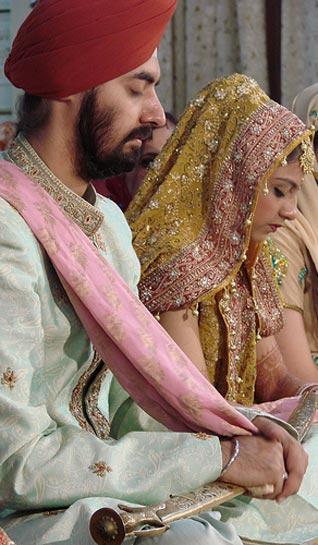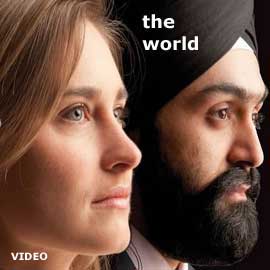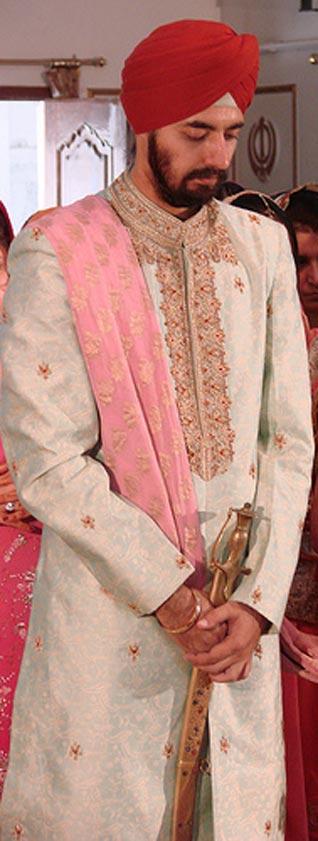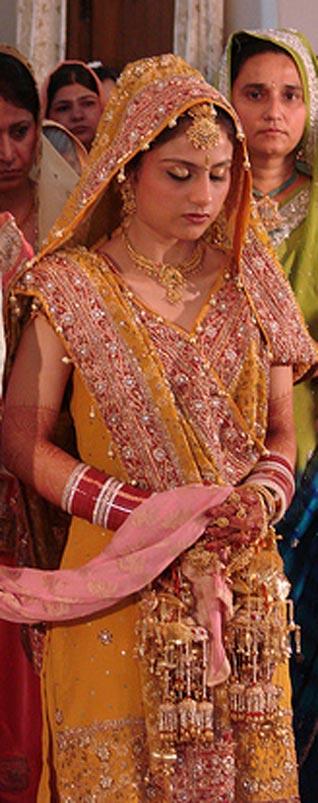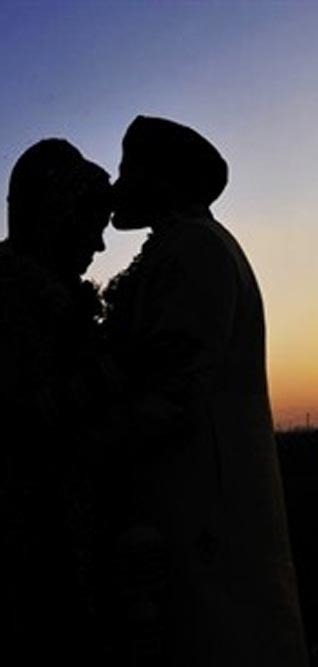Talking Stick
Anand Karaj
The Talking Stick Colloquium # 31, October 12 - 19
Convenor: RAVINDER SINGH TANEJA
Convenor's Note
We return to The Talking Stick Colloquium after a short summer hiatus. I hope all of you had a nice summer break and are ready to plunge right back into the joy and bliss of gurbani.
THE TOPIC THIS WEEK
Earlier this summer I found myself in the unusual position of "officiating" at a Sikh wedding (Anand Karaj). The occasion was the marriage of a friend's daughter, a charming and beautiful young lawyer who wished for an English interpretation to accompany the ceremony. The task fell to me!
What follows is an abridged and modified version of my narrative - to be the focus of our dialogue this week.
THE SIKH VIEW OF MARRIAGE
To understand the Sikh view of marriage, we need to turn to the third Nanak, Guru Amardas, who speaks of a marriage in purely spiritual terms: a mere physical union, he tells us, is no union at all, no matter how close; it is only when souls meet can we speak of a true union:
"They are not said to be husband and wife, who merely sit together. They alone are called husband and wife, who have one light in two bodies."
For Sikhs, then, a marriage is not merely a legal or social contract, although in a real sense it is that as well; nor is a marriage to be viewed solely as a license for physical consummation, although it is a necessary element as well..
The key to understanding the Sikh view of marriage is to view it as an unfolding of a spiritual journey. Two ego-bound individuals promise to undertake what is a solitary spiritual journey together - to transcend what is outwardly a social and
physical bond into a sacrament.
A marriage is the arena where this drama is played out.
THE MESSAGE
The hymns celebrate the wedding of the individual soul with that Great Spouse who resides in us all and should be seen as a metaphor for the development of an ideal relationship that is characterized by mutual respect, love, restraint and harmony.
The four circumambulations of the Guru Granth by the couple reflect their acknowledgement of these steps.
The first hymn is foundational in that it orients the Sikh to the "right way", in this case called "parvirti marg," or the path of an active householder. This instruction is significant: it recognizes and sanctifies marriage as the desired mode of existence and calls for an active engagement in the world.
A marriage becomes training ground for spiritual formation. After the initial euphoria wears off and when romantic illusions melt away, hard choices have to be made: between flight and unconditional love.
Depending on the choices one makes, a marriage will either become a spiritual experience where love and faith spring forth or become a prison of habitual patterns where husband and wife become locked in narcissistic ego warfare.
The right choices are made by listening to the Guru's instructions (bani) that call for the cultivation of Dharam (inner qualities or virtues) aided by fixing one's mind on the Word.
The second hymn builds on the first. A husband and wife who commit themselves to the spiritual ordeal of cultivating Dharam begin to shed their constricting egos and come to recognize the divine presence in each other. They learn to walk with awareness of the One that pervades all. This brings about a shift: one who fears God and sees the divine presence everywhere does not fear anything, but rather acts with sensitivity, moral and ethical rectitude and sympathy.
The third hymn speaks of "chao," which does not have an exact English equivalent, but could be described as Love tinged with enthusiasm and freshness. Love here knows no staleness. The affection for parents and family gives way to a more overpowering love that knows no rival. One looks to the new with enthusiasm or chao as the old recedes.
The culmination of this process is described in the concluding hymn as Sehaj - where the individual abides in a state of natural ease and a dynamic balance. This is peak spiritual experience.
THE CEREMONY
The Anand Karaj, like all Sikh rites of passage, is always performed in the presence of the Eternal Guru of the Sikhs as enshrined in the Holy Scripture called the Guru Granth Sahib and witnessed by a community of relatives and friends, called Sangat.
This mystical union of the Guru, the Eternal Teacher, and the congregation (Sangat) incorporates the presence of God in our consciousness ("vich sangat har prabh vasai jio"). The Bride and bridegroom are thus mystically seated in the lap of God,
the source of all love and affection and the blessing of the congregation is with them.
The ceremony follows the pattern below:
1 As the congregation assembles, hymns from the Guru Granth Sahib are sung. Traditionally, the ceremony begins by the singing of "Keeta lorriye kum tah(n) har peh aaikhieye " - 'At the commencement of any activity, seek the blessings of God who will aid in the successful completion of the task at hand by being an active witness.'
2 The bride and bridegroom sit facing the Guru Granth Sahib. The bride's father places an end each of a sash in the hands of the bride and groom - signifying the tying of the knot - joining together of two individuals. A specific hymn: "Pale Tende Lagi" or I have hitched myself to you is sung.
3 Ardaas (prayer) and a reading (Hukamnama) from the Guru Granth. Note that in this instance this is a familial and not congregational prayer, where only the parents and the bride and bridegroom are expected to stand, while the sangat remains seated as witness.
4 The reading is followed by singing of the for prescribed stanzas composed by the fourth Master, Guru Ram Das - collectively called the Laavaan. This is the core of the marriage ceremony.
5 The Lavan involves four circumambulations of the Guru Granth Sahib. Accompanying each of them, one of the four prescribed hymns is, in turn, first read and then sung. At the conclusion of each reading of the hymn, the bride and groom bow to the Guru Granth, get up and walk around the Scripture in a clockwise direction. As they circumambulate, the hymn is this time sung by the raagis (minstrels). After completing each circumambulation, the couple bows to the Granth Sahib and sits down, facing it.
6 As they circle the Guru Granth, the couple should do so with a feeling of faith that they are commencing on the course of a joint life to make themselves inseparably one, to make their united life a union - physical, intellectual and spiritual.
7 The singing of the celebratory "Viaah hoyah mera babula" followed by Anand Sahib or the Hymn of Bliss, which is sung after the Laavaan, signifying attainment or fulfillment.
8. Ardaas (this time, congregational, to bless the new couple) and reading from the Guru Granth.
9 Serving of karrah parshad, a sacrament consisting of a sweet pudding, signifying that the grace of God is sweet indeed.
POINTS TO PONDER
When, how and why did Sikhs come to adopt the Anand Karaj ceremony as a uniquely Sikh wedding ceremony?
What is the true import of the message in the Laavaan?
October 12, 2010
Conversation about this article
1: R. Singh (Canada), October 12, 2010, 10:13 AM.
When we translate Sikh concepts into English by using pre-existing terms like "sacrament" or "baptism" - borrowed from Christianity - the real intent or purpose of the custom or ritual is lost, due to the baggage attached to such terms. Karrah Parsad is not a 'sacrament' in my view, but more of a symbolic 'sharing' of our bounties, that is done at any and every Sikh occasion, just as the ardaas - the supplication - is not specific to weddings.
2: Ravinder Singh Taneja (Westerville, Ohio, U.S.A.), October 13, 2010, 8:12 AM.
R.Singh ji: your observation about using terms with Christian notions is spot on. We need to be more careful in the use of such borrowed words. [Editor: Mea culpa. It was my insertion.]
3: A. Kaur (London, United Kingdom), October 13, 2010, 8:33 AM.
None of my grandparents circumambulated the Guru Granth Sahib. The Laavaan then were recited while they sat before the Guru Granth Sahib and listened. And some of the shabads sung during the ceremony are also recent additions, such as the shabad 'Viyaah hoa mere Babulaa'. The Laavaan are the end of the ceremony, after which the Anand Sahib is sung, and the Ardaas recited.
4: Gurdip Singh Chana (Ilford, United Kingdom), October 13, 2010, 5:43 PM.
I am little curious with A. Kaur's comments regarding her grandparents' wedding. Can you elaborate on that, please? I was also thinking the same about the ceremony; moreover, was it conducted in the manner it was by our Fourth Guru? Anybody welcome to explain further.
5: T. Sher Singh (Mount Forest, Ontario, Canada), October 13, 2010, 6:17 PM.
My personal understanding of the development of Sikh marriage traditions is as follows: The Hindu marriage was done by circling around a havan fire while a brahmin chanted sanskrit passages and threw ghee and other condiments into the fire. The havan and all the goings-on around it were thrown out of Sikh practice by the Gurus, and with the Guruship passing to the Guru Granth Sahib, the latter eventually became the focal point of the ceremony. Starting with the end of the Guruship of the Ten Masters, all the way to the post-Sikh-Raj decades in the second half of the 19th century, the Sikh community had little time to consolidate the teachings and philosophy it had been gifted by the Gurus. Life on horseback or in fending off the invader shaped much of Sikh life. It wasn't until after the relative quiet following the fall of the Sikh Empire that Sikh intellectuals had the time and the resources, for the first extended period in Sikh history, to bring together all our philosophical riches and disseminate them amongst the masses. Ergo, the Singh Sabha Movement. It is during this phase that the Sikh marriage traditions were gleaned and codified, after weeding out any of the Hindu practices which had crept in during the lengthy period of turmoil and upheaval. The havan, which had crept back into some Sikh households, was then banished for ever. The Sikh wedding ceremony is not a ritual; it can be adapted if and when necessary. Thus, in this day and age, couples have often replaced the tradition of the bride following the groom during the circumambulations with the two walking side-by-side. I have often found at weddings in the diaspora and sometimes even on the sub-continent, that many practices are dropped, not because of idealogical reasons but merely because there is no one around to explain the whole gamut of practices. This is a good thing, not bad: as long as the central presence of the Guru Granth Sahib and the supporting cocoon of the sangat is part of the ceremony, the dropping of some 'traditions' does not, should not, constitute an infraction. However, only A. Kaur's grandparents can explain the circumstances of their own experience. I hope they will come forth, because it will only add to our knowledge about ourselves.
6: Pavneet Kaur (Delhi, India), October 14, 2010, 1:12 AM.
I have been witness to many weddings and as a child often wondered about the meaning of the hymns (laavan) that are recited. This article is very informative, in that it touches on their meaning, but I think this is just the tip of the iceberg. Each and every practice that we follow in our weddings is so full of significance and importance. I'd really love it if we could have more of such articles and discussions on this. The Sikh sangat today (especially our youngsters) need to be made aware of of why we do, what we do.
7: Ravinder Singh Taneja (Westerville, Ohio, U.S.A.), October 14, 2010, 10:04 AM.
To supplement Sher's account: there is no evidence that the Anand Karaj - as we know it - was practiced during the time of the first five Gurus. For one thing, the Adi Granth was not Guru yet, and for another, there were not enough copies to go around. None of the Rehatnamas mention (with the exception of Daya Singh's) mentions Anand Karaj. Evidently it came to be called Anand towards the end of Guru Amardas' Guruship when it became customary to recite Anand at the conclusion of Sikh ceremonies. The Singh Sabha Movement did indeed create counter rituals but I believe there was opposition to the Anand Karaj from several prominent Sikhs like Baba Khem Singh Bedi and even the Jathedar of the Akal Takht. The Anand Karaj was popularized by the Nirankari movement (Baba Sahib Dayal and Darbara Singh) - nothing to do with the pseudo 'nirankaris' of the late 1900s - and legislated in 1909 as the Anand Karaj Act by the Imperial Legislature. Would love to hear from others who have additional insights.
8: Amarpal Singh (San Jose, California, U.S.A.), October 14, 2010, 12:00 PM.
An informative article by Dr. J.S, Neki on the subject: "Anand Karaj - From Counter-ritual to Legislative Act" was published in Nishaan Magazine in 2006. A copy is available at http://www.jsneki.com/AnandKaraj_DrNeki.pdf
9: Gur Singh (Chicago, Illinois, U.S.A.), October 14, 2010, 5:58 PM.
Ravinder Singh Taneja ji: The Guru Granth has four laavaan written in black and white. There is no space for conspiracy theories by historians, in my mind at least, in respect of the Anand Karaj. T
10: Mohan Singh (Toronto, Ontario, Canada.), October 14, 2010, 11:21 PM.
Anand marriages were commonly reported in the Sikh Press towards the close of the 19th century. For instance, the Khalsa Akhbaar, in its issue of November 6, 1886, reported the marriage of Bhai Dalip Singh, son of Bhai Ram Singh of village Kondi in the princely state of Patiala, by Anand ceremony. The same newspaper announced on December 11, 1886, the Anand nuptials of Gian Singh, son of Subedar Major Baghel Singh, which took place at the village of Jaipura. Again on February 14, 1888, the Khalsa Akhbaar reported the marriage of the daughter of Bhai Sant Singh, president, Singh Sabha, Lahore, performed in accordance with the Sikh Anand ceremony. At Sialkot, an early Anand marriage of modern times took place on June 4, 1903, as reported in the Khalsa Akhbaar of July 10, 1903. Bhai Mohan Singh Vaid, in his Diary, recorded that he attended the Anand Karaj at the village of Kairon on 7 June 1899: it was the marriage of Bhai Nihal Singh Kairon`s daughter, a sister of Partap Singh Kairon (later Chief Minister of Punjab). The Anand Marriage Bill was introduced in the Imperial Legislative Council in 1908 by Tikka Ripudaman Singh of the princely state of Nabha. The Act was passed in 1909 by the Imperial (i.e. Governor General`s) Legislative Council to establish legal "validity of the marriage ceremony common among the Sikhs called Anand." The origins of marriage by Anand ceremony go back to early Sikhism. The practice which somewhat lapsed during the time of Maharaja Ranjit Singh was sought to be revived as part of the religious reform initiated by the Nirankari movement and followed up especially by the Singh Sabha. A committee of the Chief Khalsa Diwan drafted the Anand Marriage Bill. The Imperial Council referred the bill to a selection committee. The bill received overwhelming support from the Sikh respondents. Sundar Singh Majithia, member of the Imperial Council, said the ceremony called Anand was initiated by the third Guru of the Sikhs, Guru Amar Das (1479-1574), and his successor Guru Ram Das (1534-1581) was the author of the four hymns of Laavaan which are included in the Guru Granth Sahib [GGS:773] and which are recited to solemnize the Anand ceremony. (Info: The Guru Granth Sahib Academy & The Sikh Encyclopedia)
11: Ravinder Singh Taneja (Westerville, Ohio, U.S.A.), October 15, 2010, 10:33 AM.
Gur Singh ji: what conspiracy theory are you referring to? Yes, the Guru Granth does indeed have four Lavaan - in black and white as you say. I am not sure I get the point you are trying to make. Please help me understand better.
12: Baljit Singh Pelia (Los Angeles, California, U.S.A.), October 16, 2010, 1:08 AM.
Marriages are performed either in a religious ceremony or simply by civil certification. While other religious marriages are either a contract (nikah) or commitment to one another ('until death do us apart'), etc., the Anand Kaaraj initiated by Guru Ramdas takes it to a higher level of spirituality. The couple in the Anand goes through the four stages (laavaan) of acquaintance, discovery, joy and ultimately, immersion into one another. In other words, from two separate individuals to oneness in life. Together, they are also to go through the same four stages of discovering Waheguru, striving to finally immerse in him by following the path of gurbani. I would like to also point out that the Anand Kaaraj is the only mortal relationship that is sanctioned and of significance in the Guru Granth Sahib. Anand Kaaraj can be translated to mean the ceremony of bliss or ecstasy/ joy. This bliss is with regards to the perpetuation of life and the joy associated with producing and rearing a new being and the continuation of the cycle of life.
13: Gur Singh (Chicago, Illinois, U.S.A.), October 16, 2010, 1:14 PM.
Ravinder ji: Sorry, I misread some segment of one of your comments. Thanks for your reply though.
